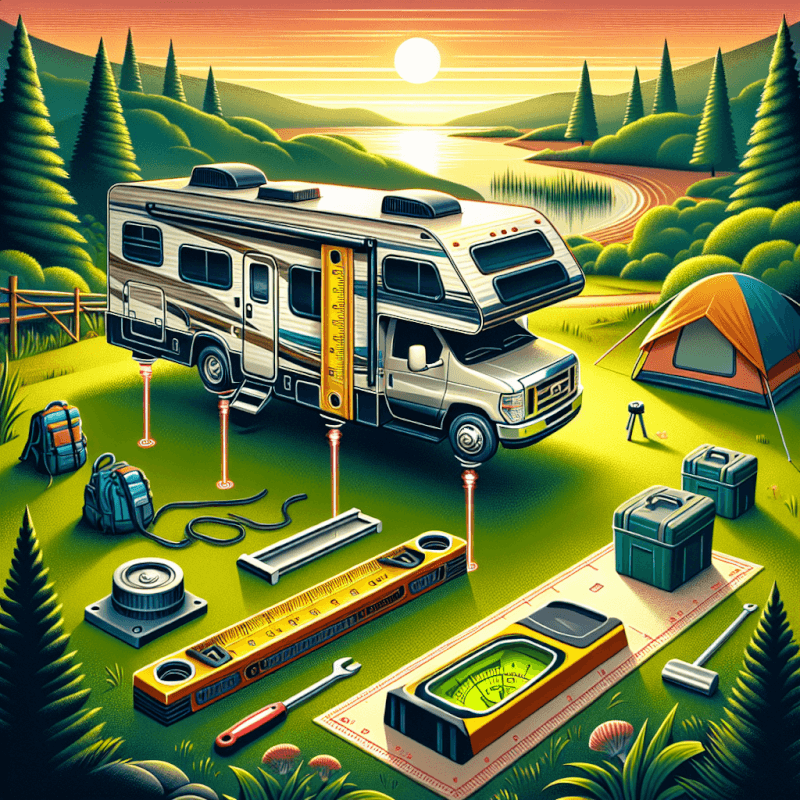Imagine the excitement as you pull into a beautiful campsite, ready to park your RV and embark on an unforgettable adventure. But as you step inside, you notice a slight tilt, the furniture swaying ever so slightly. It’s time to conquer the challenge of leveling and stabilizing your RV. Don’t worry, because in this article, we’ll guide you through the simple yet important steps to ensure a comfortable and stable experience at your campsite. From leveling jacks to stabilizing bars, we’ve got you covered. So let’s dive in and get your RV perfectly level and secure, allowing you to fully enjoy your time in the great outdoors.

Determining the Leveling Requirements
Understanding the Importance of Leveling
When it comes to RV camping, leveling your vehicle is essential for several reasons. Firstly, it ensures your comfort while inside the RV. Sleeping or moving around in an unlevel vehicle can be quite uncomfortable and may even lead to aches and pains. Secondly, leveling helps with the proper functioning of appliances and systems within the RV. An RV that is not level can cause appliances like the refrigerator to operate less efficiently, leading to potential food spoilage. Lastly, leveling your RV helps prevent potential damage to the vehicle’s structure, such as cabinets and doors swinging open unexpectedly.
Inspecting Your RV’s Leveling System
Before you start the leveling process, it’s essential to inspect your RV’s leveling system. Most RVs come equipped with built-in leveling jacks or stabilizer jacks that can be extended to level the vehicle. Take a look at these jacks to ensure they are in proper working condition. Check for any signs of wear or damage, including rust or broken parts. It’s important to address any issues with your leveling system before attempting to level your RV to ensure your safety and the longevity of your vehicle.
Using a Leveling Tool
To accurately level your RV, you will need a reliable leveling tool. There are several options available, including bubble levels, electronic levels, and smartphone apps. Bubble levels are simple and affordable tools that can be placed on a countertop or another flat surface inside your RV. Electronic levels provide a more precise measurement and can be mounted permanently in your RV. Smartphone apps are convenient and often offer additional features like slope indicators. Choose the leveling tool that suits your preferences and budget, ensuring it provides accurate readings to level your RV effectively.
Preparing Your RV for Leveling
Choosing a Suitable Campsite
Selecting the right campsite plays a crucial role in successfully leveling your RV. Look for a level ground where there are minimal slopes or inclines. Avoid areas with excessive dips or uneven terrain, as they can make the leveling process more challenging. It’s also helpful to consider the proximity of utility hookups and amenities when choosing a campsite, ensuring convenient access to water, electricity, and sewer connections. Take your time to evaluate different campsites and consider any potential challenges you may encounter during the leveling process.
Clearing the Area
Before attempting to level your RV, it’s important to clear the surrounding area of any debris or obstacles that may interfere with the process. Remove rocks, branches, or any other objects that could potentially affect the positioning of your leveling blocks or pads. Also, be mindful of low-hanging branches or overhead obstacles that could pose a risk to your RV. Clearing the area not only makes the leveling process smoother but also helps prevent any damage to your RV or blocking mechanisms.
Preparing the Stabilizer Jacks
If your RV is equipped with stabilizer jacks, it’s essential to prepare them for leveling. Stabilizer jacks provide additional stability once the RV is leveled and prevent unwanted movements while you are inside. Before extending the stabilizer jacks, ensure they are in good working condition and not damaged. Slowly extend the jacks until they make firm contact with the ground, but be careful not to overload them. Stabilizer jacks are not designed to support the weight of the RV; their purpose is to reduce movement and sway when the RV is parked.
Leveling Your RV
Using Blocks or Leveling Pads
Leveling blocks or pads are often the most common method used to level an RV. These are stackable blocks or pads that can be placed underneath the RV’s wheels to raise or lower specific areas of the vehicle. They are typically made of durable materials like plastic or wood and come in various sizes and shapes. Leveling blocks provide a convenient and cost-effective way to achieve a level RV.
Placing the Blocks or Pads
To start the leveling process, place the leveling blocks or pads in front of or behind the appropriate wheels, depending on the slope of the campsite. If the ground slopes downward towards the front of your RV, place the blocks or pads in front of the wheels. If the slope is towards the back, position them behind the wheels. Be sure to position the blocks or pads evenly so that the weight of the RV is distributed properly.
Driving onto the Blocks or Pads
Once the blocks or pads are in place, slowly drive your RV onto them, carefully aligning the wheels with the blocks or pads. Use a spotter outside the vehicle to guide you during this process, ensuring that you position the wheels accurately on the blocks or pads. Take your time and proceed slowly to avoid any sudden movements or potential damage to your RV or the leveling blocks.
Checking the Level
After driving onto the blocks or pads, check the level of your RV using your chosen leveling tool. Place the tool on a flat surface inside the RV, such as a countertop or table, and observe the reading. If the tool indicates that the RV is not level, you may need to make adjustments by adding or removing blocks or pads under the wheels. Repeat the process until the RV is level and stable.
Fine-tuning the Level
Sometimes, achieving a perfectly level RV requires further fine-tuning. If your RV still feels slightly off-balance, you can make minor adjustments using the leveling blocks or pads. Add or remove blocks incrementally until you achieve the desired level position. It’s important to remember that achieving a perfectly level RV may not always be possible due to the terrain or other factors. Aim for a comfortable and stable position that allows for proper operation of appliances and systems within your RV.
Stabilizing Your RV
Understanding the Importance of Stabilizing
While leveling your RV ensures a comfortable interior and proper appliance function, stabilizing your vehicle prevents unwanted movements and swaying. Stabilization plays a vital role in enhancing your camping experience by reducing the risk of accidents or damage to the RV’s structure. By deploying stabilizer jacks or using additional stabilization methods, you can significantly improve stability and ensure a safe and comfortable campsite.
Utilizing Stabilizer Jacks
Most RVs come equipped with stabilizer jacks that can be extended to provide additional stability. These jacks are typically located on the corners of the RV’s frame and can be manually or electronically operated. Stabilizer jacks work by supporting the weight of the RV and reducing the movement caused by people walking inside, wind, or other external forces. Deploying your stabilizer jacks is an essential step in stabilizing your RV once it is leveled.
Positioning the Stabilizer Jacks
Before extending the stabilizer jacks, it’s crucial to position them properly. Each corner of your RV should have a stabilizer jack, and they should be placed in a way that provides optimal support. Refer to your RV’s owner’s manual for specific instructions on the appropriate positioning of the stabilizer jacks. Positioning the jacks correctly ensures maximum stability and prevents any unnecessary strain on the RV’s frame.
Deploying and Adjusting the Jacks
Once the stabilizer jacks are correctly positioned, it’s time to deploy and adjust them. If your RV has manual stabilizer jacks, use a crank or a suitable tool to extend them until they make firm contact with the ground. Avoid overextending the jacks, as this can cause damage or reduce their effectiveness. If your RV has electronic stabilizer jacks, follow the manufacturer’s instructions on how to operate them safely.
Using Additional Stabilization Methods
In addition to using stabilizer jacks, there are several additional methods you can use to enhance stability. Using chocks, which are wedges placed against the tires, can help prevent any unintentional movement or rolling. Balancing the weight distribution inside the RV by positioning heavy items closer to the center can also improve stability. Some RV owners choose to invest in aftermarket leveling systems that provide automatic or hydraulic leveling, offering an even more robust stabilization solution. Explore these additional methods and find the ones that work best for your RV and camping style.

Additional Tips for Leveling and Stabilizing
Using Chocks for Extra Stability
To further enhance stability and prevent any unwanted movement, it’s recommended to use chocks. Chocks are wedges that can be placed against the wheels of your RV to keep them in place. Once your RV is leveled and stabilized, position the chocks snugly against the tires to prevent any accidental rolling. This extra layer of stability will provide peace of mind during your camping adventures.
Balancing Weight Distribution
Proper weight distribution inside your RV not only helps with stability but also ensures a smoother ride while on the road. Avoid overweighting one side of your RV by evenly distributing heavy items throughout the vehicle. Place heavier items closer to the center and ensure nothing is excessively concentrated on one side. Balancing weight distribution will help prevent any tilting or swaying and contribute to an overall more stable camping experience.
Checking for Proper Wheel Contact
After leveling and stabilizing your RV, it’s important to double-check that all wheels are in firm contact with the blocks, pads, or ground. Ensure there is no visible gap between the wheels and the leveling device or ground to prevent any accidents or instability. If you notice any inconsistencies, make the necessary adjustments before settling into your campsite to ensure a secure and stable foundation for your RV.
Considering Aftermarket Leveling Systems
If you frequently camp or RV and find yourself struggling with manual leveling and stabilizing methods, you may want to consider investing in aftermarket leveling systems. These systems offer automatic or hydraulic leveling options, minimizing the time and effort required to achieve a level and stable RV. Before making a purchase, research different systems, read reviews, and consult with experts or fellow RV owners to determine the best option for your specific needs and budget.
Maintaining an Even Keel
Regularly Inspecting and Maintaining Leveling Systems
Just like any other component of your RV, leveling systems require regular inspection and maintenance to ensure they function properly. Inspect your leveling jacks, blocks, pads, or any other leveling devices for signs of wear or damage. Check for loose bolts, rust, or any other issues that may impact their effectiveness. If you spot any concerns, address them promptly by repairing or replacing the components as needed. Regular maintenance will help extend the lifespan of your leveling systems and provide a more reliable camping experience.
Checking for Any Sign of Wear or Damage
During your routine inspections, pay close attention to any signs of wear or damage on your leveling systems. This includes looking for cracks, dents, or any visible signs of deterioration. Additionally, inspect hydraulic or electronic components for leaks, loose wires, or other malfunctions. Any indication of wear or damage should be taken seriously and addressed promptly to prevent further complications.
Replacing or Repairing Components as Needed
If you discover any issues during your inspections, it’s crucial to take the necessary steps to repair or replace the affected components. Consult your RV’s owner’s manual for guidance, or seek assistance from a professional RV technician if you’re unsure how to proceed. Remember that maintaining a properly functioning leveling system is essential for the safety and stability of your RV, so don’t delay in addressing any necessary repairs or replacements.

Ensuring a Safe and Comfortable Campsite
Preventing Unwanted Movements and Swaying
By leveling and stabilizing your RV, you significantly reduce the risk of unwanted movements and swaying while inside. This can make a significant difference in your overall camping experience. When your RV is properly leveled and stabilized, you can move around more freely without feeling off-balance. Additionally, stabilizing your RV minimizes the movement caused by external forces such as wind or people walking inside the RV, providing a safer and more comfortable environment for everyone.
Improving Stability for a Better Night’s Sleep
One of the most important aspects of camping is getting a good night’s sleep. Leveling and stabilizing your RV allows for a more restful sleep by eliminating the discomfort caused by an unlevel or unstable vehicle. When your RV is properly leveled, you won’t experience the sensation of sliding or rolling off the bed during the night. Stabilizing your RV reduces the movements caused by people moving inside or the RV’s suspension reacting to external factors, ensuring a peaceful and uninterrupted sleep.
Avoiding Damage to the RV’s Structure
Leveling and stabilizing your RV not only enhances your comfort and safety but also prevents potential damage to the vehicle’s structure. When an RV is unlevel, doors and cabinets may swing open unexpectedly, potentially causing damage to the RV’s interior or contents. By maintaining a level RV, you minimize the risk of these incidents, reducing the chances of accidents or costly repairs. Ensuring a safe and damage-free RV structure allows you to enjoy your camping trips without unnecessary worries.
Ensuring Level Floors and Proper Appliance Function
Preventing Doors and Cabinets from Swinging
An unlevel RV can result in doors and cabinets swinging open or not closing properly. This can be not only frustrating but also potentially dangerous. By leveling your RV, you minimize the risk of these occurrences. When all surfaces are level, doors and cabinets will stay shut and secure, reducing the chances of accidental spills, breakage, or injuries. Take the time to properly level your RV to ensure all doors and cabinets remain in their intended positions.
Ensuring Proper Operation of Appliances
Many appliances in your RV, such as refrigerators, stoves, and ovens, rely on being level to operate efficiently. An unlevel RV can compromise the functioning of these appliances, causing issues like inconsistent temperature control, reduced cooking effectiveness, or even appliance failure. Leveling your RV ensures that appliances can operate optimally, improving your overall camping experience and preventing potential frustrations or inconveniences.
Avoiding Uneven Refrigerator Operation
The refrigerator is one of the most essential appliances in an RV, and its proper operation is highly dependent on being level. When an RV is unlevel, the refrigerator may not cool evenly, leading to potential food spoilage or unsafe storage conditions. Leveling your RV is critical in ensuring that your refrigerator operates as intended, keeping your food fresh and safe throughout your camping trip. Take the time to level your RV before setting up camp to ensure smooth and consistent refrigerator operation.

Conclusion
Leveling and stabilizing your RV are crucial steps to take before embarking on your camping adventures. It ensures your comfort, the proper functioning of appliances, and the structural integrity of your vehicle. By understanding the importance of leveling, inspecting your RV’s leveling system, and using the appropriate leveling tools, you can efficiently level your RV at a campsite. Preparing your RV by choosing a suitable campsite, clearing the area, and preparing the stabilizer jacks is essential for a successful leveling process.
Using blocks or leveling pads, placing them correctly, and driving onto them allows you to achieve a level position. Checking the level with a reliable leveling tool and fine-tuning if necessary ensures a stable RV. Stabilizing your RV by utilizing stabilizer jacks, positioning them correctly, and deploying and adjusting them offers additional stability, reducing unwanted movement and swaying. Considering additional stabilization methods such as chocks, weight distribution, and aftermarket leveling systems further enhances stability.
Maintaining an even keel requires regular inspections and maintenance of the leveling system, promptly addressing any signs of wear or damage, and replacing or repairing components as needed. Leveling and stabilizing your RV ensure a safe and comfortable campsite by preventing unwanted movements and swaying, improving stability for a better night’s sleep, and avoiding damage to the RV’s structure. Level floors and proper appliance function are a result of leveling, preventing doors and cabinets from swinging, ensuring proper operation of appliances, and avoiding uneven refrigerator operation.
By following these guidelines and taking the necessary steps to level and stabilize your RV, you can ensure a safe, comfortable, and enjoyable camping experience every time. So, next time you arrive at a campsite, take the time to level and stabilize your RV to start your adventure on the right foot.


